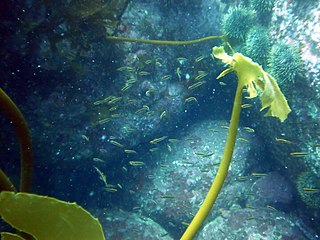
The oblique-swimming triplefin, Forsterygion maryannae, is a triplefin, found along the north east coast of the North Island of New Zealand from depths of about 5 m to 50 m. They are the only triplefins not to spend most of their time resting on the bottom, instead swimming in loose schools of up to hundreds of individuals above rocky reefs. When swimming their head is higher than the tail, giving rise to their common name.

Malacoctenus boehlkei, the Diamond blenny, is a species of labrisomid blenny native to the central western Atlantic Ocean and the Caribbean Sea where it is an inhabitant of coral reefs at depths of from 5 to 70 metres. This species can reach a length of 6.4 centimetres (2.5 in) TL. The specific name honour the ichthyologist James E. Böhlke (1930-1982), of the Academy of Natural Sciences of Philadelphia.
Enchelyurus petersi is a species of combtooth blenny found in the western Indian Ocean, in the Red Sea. This species grows to a length of 5.4 centimetres (2.1 in) SL. The specific name honours the German naturalist and explorer Wilhelm Peters (1815-1883) who named the genus Enchelyurus for the similar species E. flavipes in 1868.
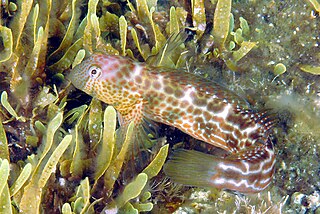
Microlipophrys canevae is a species of combtooth blenny found in the northeast Atlantic Ocean near Portugal and in the Mediterranean Sea. This species grows to a length of 7.5 centimetres (3.0 in) TL.

Zvonimir's blenny is a species of combtooth blenny found in the Mediterranean and Black Sea. This species reaches a length of 7 centimetres (2.8 in) TL. The identity of the person honoured in the specific name is uncertain but is thought to be the Medieval King of Croatia and Dalmatia Demetrius Zvonimir who reigned from 1075-1089 probably in allusion to the area where the type was collected.
Praealticus oortii is a species of combtooth blenny found in the eastern Indian Ocean from the Andaman Sea to Timor in the western Pacific. The identity of the person honoured by the specific name of this blenny was not specified but it is thought to be most likely to be the draftsman and illustrator Peter van Oort (1804-1834), who, as part of the Physics Commission for the Dutch East Indies, explored Java which is the type locality of this species.

Ecsenius aroni, known commonly as the Aron's blenny, is a species of combtooth blenny found in coral reefs in the western Indian ocean, from the Red Sea and the Gulf of Aqaba south to Djetta in Saudi Arabia and Towartit Reef near Port Sudan. The specific name honours the oceanographer William Aron of the Smithsonian Institution.

Pomatoschistus bathi is a species of goby native to the eastern Mediterranean and the Sea of Marmara where it occurs at depths of from 7 to 14 metres on substrates with a sand or mud component. This species can reach a length of 3 centimetres (1.2 in) TL. It is found in Mediterranean Sea and Black Sea, with scattered records in southwestern France to Turkish Aegean Sea coast. The Bath's goby feeds on bosmiden, brine shrimps, lobster eggs, oyster eggs, zoobenthos and zooplankton. In 2013, it was listed as data deficient but was changed to Least Concern the following year because the population is thought to stable, it may be under-represented and there are no known threats. The specific name honours the German ichthyologist Hans Walter Bath (1924-2015).
Malacoctenus erdmani is a species of labrisomid blenny native to the western Atlantic Ocean and the Caribbean Sea from the Bahamas to Curaçao. This species is an inhabitant of reefs where it prefers areas that provide hiding places such as coral rubble and rock and patches of algae. It can reach a length of 3.8 centimetres (1.5 in) TL. The specific name honours the fishery biologist Donald S. Erdman.
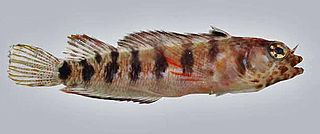
Starksia smithvanizi, the brokenbar blenny, is a species of labrisomid blenny native to the Caribbean Sea. It is found on reefs around islands at depths of from very shallow waters to 6 m (20 ft). This species can reach a length of 2 cm (0.79 in) SL. The specific name honours the ichthyologist William F. Smith-Vaniz.
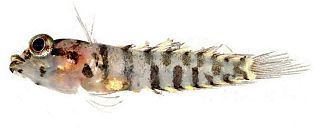
Starksia starcki, the key blenny, is a species of labrisomid blenny native to the Caribbean Sea. It inhabits coral reefs, preferring surge channels at depths of from 6 to 19 m. This species can reach a length of 4 cm (1.6 in) TL. It is also found in the aquarium trade. The specific name honours the Walter A Starck II in recognition of his contributions to marine biology.

Enneanectes jordani, known commonly as the redbelly triplefin and the mimic triplefin, is a species of triplefin blenny from the northern Caribbean Sea and the Gulf of Mexico south as far as Venezuela. The specific name honours the American ichthyologist David Starr Jordan (1851-1931). Some authorities consider the synonym Enneanectes pectoralis to be a valid species.

Tripterygion tartessicum is a species of fish in the family Tripterygiidae, the threefin blennies. It is widespread in the Mediterranean Sea and eastern Atlantic Ocean, where it occurs along the southern coast of Spain and from Morocco to Tunisia. It is a tropical demersal fish measuring up to 7.7 centimetres (3.0 in) in length.
Enneapterygius larsonae, known commonly as the Western Australian black-head triplefin, is a species of triplefin blenny in the genus Enneapterygius. It was described by the German ichthyologist Ronald Fricke in 1994. The specific name honours Helen K. Larson, the Curator of Fishes at the Museum and Art Gallery of the Northern Territory in Darwin, Australia, who collected the type.
Enneapterygius ziegleri, known commonly as the Ziegler's triplefin, is a species of triplefin blenny in the genus Enneapterygius. It was described by Ronald Fricke in 1994. Its specific name honours Bernhard Ziegler (1929-2013), a paleontologist and Director of the State Museum of Natural History in Stuttgart, Germany. This species occurs in the Timor Sea of Indonesia and East Timor and in the Philippines.

Roche's snake blenny is a fish species in the genus Ophidion and the family Ophidiidae. Widespread in the Mediterranean Sea in western and northern regions, also in the Black Sea, Sea of Marmara and it has been recorded in the Atlantic. Marine subtropical demersal fish, up to 29.3 centimetres (11.5 in) long. The specific name honours the Swiss physician and naturalist François-Etienne Delaroche (1780-1813), who wrote about the distinctive swim-bladder anatomy of Ophidion barbatum in 1809.
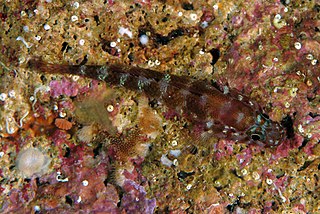
Steinitz's goby is a species of goby. It is native to the Mediterranean Sea near Marseilles. Recently recorded in the Adriatic Sea in Croatia, Tyrrhenian Sea in Italy, and in the Black Sea in Ukraine. This species can be found in underwater grottoes in inshore waters at depths of from 2 to 15 metres. It can reach a length of 3.8 centimetres (1.5 in) SL. The specific name honours the marine biologist and herpetologist Heinz Steinitz (1909-1971) of the Hebrew University, Jerusalem.
The Dead Sea toothcarp is a subspecies of the Arabian toothcarp that is endemic to the Dead Sea basin, although molecular evidence suggests that it should be regarded as a species. It is threatened by water fluctuation, and the introduction of cichlids and Gambusia. The sub-specific name of this fish honours the Scottish surgeon and naturalist John Richardson (naturalist) (1787-1865) who first reported killifish in the Dead Sea basin.

The northern whitefin gudgeon is a species of freshwater fish in the family Cyprinidae. It is distributed in the northern Black Sea basin, southern Baltic Sea basin, southern North Sea basin. Also, reports from lakes Ilmen and Ladoga and its basins have been made, which are questionable. Their maximal length is 11.5 cm, with a maximal reported age of 5 years.

Diplecogaster bimaculata, the two-spotted clingfish, is a species of fish in the family Gobiesocidae found in Black Sea, Mediterranean Sea and Atlantic Ocean where it is found on rocks and among seagrass or shell beds.














